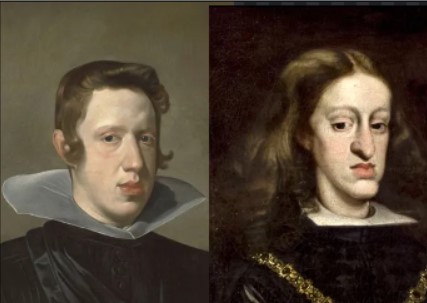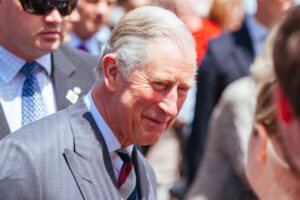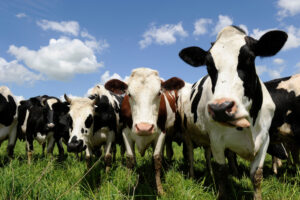INBREEDING ROYALS

Born in 1661, King Charles II of Spain was the last Habsburg ruler of the country. The family's inbreeding was of epic proportions. Inbreeding caused their mandibular prognathism.
By Ruthie DiTucci
A recent dinner discussion about strong family traits through history brought a great deal of laughter to our lakeside dining table. It seems that across the tapestry of European history, few families weave quite as intricate a portrait as the Habsburgs.
From their Habsburgian chins, a testament to generations of intermarriage, to their sprawling empires, they were defined by both grandeur and controversy. One of the most striking aspects of their reign – and arguably the source of much of their notoriety – was their rampant inbreeding, a practice that secured their wealth and lands but ultimately came at a steep genetic cost.
The Habsburgs’ rise to power began in the 13th century. Through strategic marriages and shrewd political maneuvering, they amassed territory and influence, culminating in the reign of Charles V, Holy Roman Emperor and King of Spain. Charles, a figure of immense political and cultural significance, embodied the Habsburg ambition to unite fragmented Europe under their banner. However, this ambition manifested in a troubling way – through an obsession with dynastic purity and the preservation of Habsburg bloodlines.
To achieve this, the Habsburgs turned to their own family tree. Marriages between cousins, nieces, and nephews became commonplace, a practice fueled by the belief that keeping wealth and power within the family would strengthen their hold on Europe. This strategy, while seemingly effective in the short term, had disastrous consequences.
The genetic legacy of their inbreeding was evident in the prominent Habsburg jaw, a pronounced underbite that became almost a dynastic trademark. But the physical manifestations were only the tip of the iceberg. Generations of genetic mixing led to a plethora of health problems, including epilepsy, mental illness, and physical deformities. Charles II, the last direct Habsburg monarch of Spain, was a tragic example. Incapable of ruling due to severe physical and mental incapacities, he bore the brunt of his family’s genetic gamble.
Beyond the personal tragedies, the Habsburgs’ inbreeding had wider political implications. Their obsession with dynastic purity blinded them to the changing power dynamics in Europe. While the Habsburgs clung to outdated notions of imperial unity, smaller nations around them grew in strength and independence.
By the 18th century, the Habsburg empire was in decline, a hollow shell of its former glory, its decline arguably hastened by the genetic weakness wrought by years of intermarriage.
The Habsburgs’ story serves as a cautionary tale. Their ambition, while powerful, was ultimately self-destructive. Their inbreeding policy, conceived to secure their power, instead undermined it by prioritizing bloodlines over political realities and human well-being. Their chins, though distinctive, became a symbol of their downfall, a stark reminder of the dangers of sacrificing everything for the sake of dynastic purity.
In conclusion, the Habsburgs’ inbreeding practices were a fascinating yet disturbing element of their reign. While it helped consolidate their power and wealth for a period, the long-term genetic consequences and political ramifications exposed the fallacy of their strategy. Their story serves as a reminder that while dynastic ambitions may be powerful, ultimately, the truest measure of success lies not in territorial possessions but in the well-being and progress of the people they govern.
THE BLOODLINES
The connection between the Habsburgs of Spain and Austria, and the Hanover dynasty that still rules the UK today is a bit indirect, but fascinating nonetheless. Here’s a breakdown:
1. The Habsburg Split:
- In the 16th century, the Habsburg dynasty split into two major branches:
- Spanish Habsburgs: Ruled Spain and its vast overseas colonies.
- Austrian Habsburgs: Ruled the Holy Roman Empire (later Austria-Hungary).
2. Intermarriage and Shifting Dynasties:
- Both branches practiced intermarriage within the family and with other European royal houses to consolidate power and maintain their bloodlines.
- Notably, Philip II of Spain (Spanish Habsburg) married Mary I of England (Tudor dynasty) in 1554, briefly uniting the Spanish and English crowns.
3. The Glorious Revolution and the Hanoverians:
- In 1688, the Glorious Revolution in England overthrew the Catholic Stuart dynasty and placed William III of Orange and his wife Mary II (both Protestant) on the throne.
- Mary II was a granddaughter of Charles I of England and his wife Henrietta Maria, who was a sister of Ferdinand III, Holy Roman Emperor (Austrian Habsburg).
- This distant Habsburg connection, along with William’s Protestant faith, made him an acceptable choice for the English Parliament.
4. The Act of Settlement and the Hanoverian Succession:
- To prevent future Catholic monarchs, the English Parliament passed the Act of Settlement in 1701.
- This act designated Sophia of Hanover (granddaughter of James I of England and VI of Scotland) as heir to the throne, bypassing several closer Catholic relatives.
- Sophia was a Welf princess, but her marriage to Ernest Augustus, Elector of Hanover, brought the Welf and Hanoverian lines together.
5. George I, the First Hanoverian Monarch:
- When Queen Anne died in 1714, Sophia had already passed away, so her son George Louis, Elector of Hanover, ascended the British throne as King George I.
- He founded the Hanoverian dynasty, which ruled Great Britain (and later the United Kingdom) until the death of Queen Victoria in 1901.
Connections and Influences:
- While the Habsburg-Hanoverian link is distant, it played a crucial role in shaping British history.
- The Glorious Revolution’s emphasis on Protestantism and Parliamentarianism, with a touch of Habsburg blood, paved the way for a Hanoverian monarch acceptable to both the crown and the people.
- The Hanoverian dynasty, though German in origin, ruled Britain for nearly two centuries, leaving a lasting impact on its culture, politics, and institutions.
Transformation of House of Hanover to House of Windsor
The shift from the House of Hanover to the House of Windsor in 1917 was a pivotal moment in British history, driven by the anti-German sentiment that gripped the nation during World War I. Here’s a genealogy chart illustrating the change:
Pre-War Hanover:
- Queen Victoria (r. 1837-1901): The last Hanoverian monarch on the British throne, Victoria reigned for 63 years and saw the British Empire reach its peak.
- Edward VII (r. 1901-1910): Victoria’s eldest son, Edward, ascended the throne upon her death. He was born into the House of Saxe-Coburg and Gotha, a German ducal family.
The Shift to Windsor:
- George V (r. 1910-1936): Edward’s son, George V, inherited the throne in 1910. However, with Britain at war with Germany in 1917, the German-sounding name Saxe-Coburg and Gotha became increasingly unpopular.
- July 17, 1917: To distance the royal family from their German roots, King George V issued a royal proclamation declaring that all descendants of Queen Victoria in the male line who were British subjects would bear the surname Windsor.
Post-War Windsor:
- George V (continued): The king himself adopted the Windsor surname, marking the official (hypocritical) transition of the dynasty.
- Subsequent monarchs: All subsequent British monarchs, including George VI, Elizabeth II, and Charles III, have belonged to the House of Windsor.
The House of Hanover was German and had ruled Great Britain and Ireland from 1714 to 1901. the british hated everything german (due to wwi). in 1917, King George V changed the name of the royal house to Windsor, a “power grab” move in order for the german family to keep control of the british monarchy in spite of the family’s German roots.
House of Hanover
- Sophia of Hanover (1630-1714) (Granddaughter of James I of England and Scotland)
- Ernest Augustus, Duke of Brunswick-Lüneburg (1634-1698)
- George I, King of Great Britain (1714-1727)
- Sophia Dorothea of Celle (1666-1726)
- George II, King of Great Britain (1727-1760)
- Caroline of Ansbach (1683-1737)
- Frederick, Prince of Wales (1707-1751)
- Augusta of Saxe-Gotha (1719-1772)
- George III, King of Great Britain (1760-1820)
- Charlotte of Mecklenburg-Strelitz (1744-1818)
- George IV, King of the United Kingdom (1820-1830)
- Caroline of Brunswick (1768-1821)
- William IV, King of the United Kingdom (1830-1837)
- Adelaide of Saxe-Meiningen (1792-1849)
- George IV, King of the United Kingdom (1820-1830)
- Charlotte of Mecklenburg-Strelitz (1744-1818)
- George III, King of Great Britain (1760-1820)
- Augusta of Saxe-Gotha (1719-1772)
- Frederick, Prince of Wales (1707-1751)
- Caroline of Ansbach (1683-1737)
- George II, King of Great Britain (1727-1760)
- Sophia Dorothea of Celle (1666-1726)
- George I, King of Great Britain (1714-1727)
- Ernest Augustus, Duke of Brunswick-Lüneburg (1634-1698)
House of Windsor (formerly Saxe-Coburg and Gotha)
- Victoria, Queen of the United Kingdom (1837-1901) (Granddaughter of George III)
- Albert, Prince Consort (1819-1861)
- Edward VII, King of the United Kingdom (1901-1910)
- Alexandra of Denmark (1844-1925)
- George V, King of the United Kingdom (1910-1936)
- Mary of Teck (1867-1953)
- Edward VIII, King of the United Kingdom (1936-Abdication 1936)
- Wallis Simpson (1896-1986)
- George VI, King of the United Kingdom (1936-1952)
- Elizabeth Bowes-Lyon (1900-2002)
- Queen Elizabeth II, Queen of the United Kingdom (1952-present)
- Prince Philip, Duke of Edinburgh (1921-2021)
- Charles III, King of the United Kingdom (2023-present)
- Lady Diana Spencer (1961-1997)
- Charles III, King of the United Kingdom (2023-present)
- Prince Philip, Duke of Edinburgh (1921-2021)
- Queen Elizabeth II, Queen of the United Kingdom (1952-present)
- Elizabeth Bowes-Lyon (1900-2002)
- Edward VIII, King of the United Kingdom (1936-Abdication 1936)
- Mary of Teck (1867-1953)
- George V, King of the United Kingdom (1910-1936)
- Alexandra of Denmark (1844-1925)
- Edward VII, King of the United Kingdom (1901-1910)
- Albert, Prince Consort (1819-1861)
Connection to King Charles II:
- Sophia of Hanover was the granddaughter of James I of England and Scotland, who in turn was the great-uncle of Charles II.


